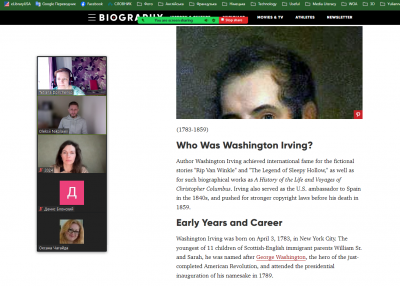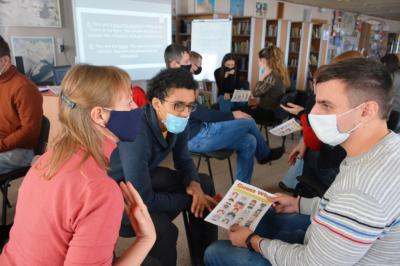Louis Armstrong
Louis Armstrong
Satchmo — A Founding Father of Jazz
1901-1971
"What he did, what he played, came from within, and from his mind. . . . It was Louis, what he was, the essence of his being".
—Bassist Arvell Shaw, in the Ken Burns TV special Jazz
So hallowed is Louis Armstrong in the literature of jazz that he would seem to be the very rock upon which the temple of jazz is built. His full-page obituary in the New York Times, July 7, 1971, stated, "It was he, more than any other individual, who built Jazz into a unique art form." As a trumpet virtuoso, he was virtually without peer in his prime. Modern trumpeter Miles Davis has said that no horn player has blown anything that Louis hadn't already played.
One of the great pop singers, Bing Crosby, whose early background was jazz, called Armstrong the beginning and end of American music.
In addition to his other talents, Armstrong was a pure entertainer. He loved to please his audience, clowning and displaying his wide-mouth, toothy grin and occasionally singing pop and show tunes. As a result, Armstrong de¬veloped a far broader audience than most purist jazz stars. He was sometimes criticized for this. But Louis stated that he didn't need to heed detractors who couldn't tell one note from another telling him how to blow his horn.
Louis Daniel Armstrong was born on August 4, 1901 (earlier sources say July 4, 1900), in New Orleans, Louisiana, in the toughest part of the city. In New Orleans music was everywhere—Negro spirituals and blues, dance music, funeral marching bands, classical music, and Creole rhythms, all of which Louis absorbed. He began doing odd jobs at an early age to help support his family, including his mother Mary Ann (called Mayann), the granddaughter of slaves. His father left home when Louis was an infant. During his early boyhood Louis was "adopted" by a Jewish family, the Karnofskys, who put him to work on their junk wagon. The first money he earned in music, however, was from singing in the streets.
A turning point in his life came when he was twelve. On New Year's Eve 1912, Louis "was street singing and celebrating. At midnight, all sorts of fireworks went off, and the impulsive Louis, wanting to join the fun, pulled out a blank-loaded pistol belonging to one of his mothers boyfriends and fired shots into the air. That was exciting for Louis but not for the police, who quickly arrested the youth and sent him off to the Colored Waif's Home for Boys.
Years later he reflected that this was the best thing that could have happened to him. It was at the home that Louis bonded with music. Louis soon joined the chorus and band, where he learned bugle and then cornet. When he left the home after eighteen months, he knew that music would be his life.
During his early teen years Louis played whenever he could. A big break came when he was taken under the wing of Joe "King" Oliver, then the featured trumpet with Kid Ory's band. Oliver tutored Louis, and when Oliver decided in 1918 to head for the flourishing Chicago music scene, Louis replaced him in Kid Ory's band. Louis now made a living blowing hot cornet in New Orleans dives, and soon he joined up with Fate Marable and his Jazz Syncopaters, playing aboard Mississippi River steamboats.
It was not long before places like Kansas City, Missouri, and Chicago began clamoring for top jazz talent. King Oliver, in Chicago, remembered his young protege and tried to convince him that great opportunity awaited him in the big city. Louis was reluctant. He enjoyed the riverboat scene and he was playing with great musicians, such as Warren "Baby" Dodds and Jack Teagarden. He had also married for the first of several times. But the lure of Chicago was tough to resist, and in 1922 Louis packed his cornet and left New Orleans to join Oliver's Creole Jazz Band.
Armstrong had no patience with the business side of music, and he welcomed the management of his educated wife. She urged him to leave Oliver, who she insisted did not allow Armstrong to fully display his skills. When an invitation came to join the Fletcher Henderson orchestra in New York, they accepted. Henderson already had a national jazz reputation.
The dignified, college-educated Henderson and earthy Armstrong were a contrast in styles. Henderson was smooth and sophisticated, and Armstrong loved to clown. Henderson's orchestra was disciplined and played from written charts, whereas Armstrong had formerly played mostly by ear. But the young cornetist's talent overcame all. Working in a large group restricted his playing, but Armstrong recorded with other artists, and on those recordings Armstrong blazed through the full range of his instrument.
In November 1925 Lil persuaded Armstrong to return to Chicago and join her in a band at the Dreamland Ballroom.
During this second Chicago stay Armstrong formed the Hot Five and the Hot Seven, exclusively for recordings during 1926—1928. They cut such Armstrong classics as "Cornet Chop Suey," "Potato Head Blues," and "West End Blues." The last of these, distinguished by Armstrong's brilliant opening cadenza, is sometimes considered his masterpiece and a turning point in jazz history. During one recording session, he is said to have dropped the lyric sheet just as he stood to sing. Whether or not he dropped it, he replaced the lyrics with nonword vocal sounds that some consider the beginning of scat singing.
Armstrong was back in New York in 1929, playing clubs and also appearing in a Broadway revue, Hot Chocolates, in which he performed Fats Waller's "Ain't Misbehavin," Louis's first really big hit song. In the early 1930s he fronted a number of big bands and traveled extensively, including a triumphant return to New Orleans. In 1932 Lil and Louis were separated. That year, feeling the pressures of both work and domestic problems, Armstrong took off for Europe. During his Palladium appearance in London, one critic referred to him as "Satchmo," a corruption of his nickname "Satchelmouth," and the new nickname stuck. (He was also called "Pops.") At one point a contingent of skeptical British musicians examined his horn, believing it had been rigged to allow him to play with such power and technique.
Armstrong returned for a much longer European tour from 1933-1935, accompanied by a new girlfriend, Alpha Smith, who was his companion for more than ten years and his wife for one. His travels ranged from Italy to Scandinavia, bringing acclaim everywhere he played.
Despite his popularity, Armstrong was in rough financial straits, and when he returned to the United States, he enlisted an old friend, Joe Glaser, as his manager. His finances improved thereafter, especially when he broke attendance records at the Apollo Theater in New York and signed a new recording contract with Decca. Hosting a summer network radio program in 1936 and appearing in numerous high-end supper clubs through the late 1930s, he helped break the barrier for booking black entertainers. He also made the first of several Carnegie Hall appearances and began a movie career, which eventually would include Pennies from Heaven, The Glen Miller Story, and High Society. In 1942 Armstrong married for the fourth time. His new wife, former showgirl Lucille (Brown Sugar) Wilson, would remain with him for the rest of his days. By the late 1940s, the big band craze was diminishing and a new interest in modern, progressive jazz was growing. But Armstrong frowned on modern jazz, and he formed Louis Armstrong and his All Stars, playing an updated New Orleans style jazz. All Stars was a fitting name, for the group included such artists as clarinetist Barney Bigard, trombonist Jack Teagarden, drummer Big Sid Catlett, and pianist Earl "Fatha" Hines. Armstrong and Velma Middleton shared the vocals.
The АД Stars toured Europe and were invited to the first international jazz festival in Nice, France, in 1948.Through the 1950s and 1960s Armstrong toured the Far and Middle East, Latin America, Africa, and Eastern Europe. These trips were sometimes sponsored by the U.S. government, which recognized the goodwill value of the genial entertainer. His 1960 trip to the Congo occurred when that country was fighting a civil war, but a truce was declared for the performance, and Armstrong was carried into the stadium on a makeshift throne.
Armstrong regained his popularity, and in 1960 he appeared in another movie, Paris Blues, along with Duke Ellington. He continued to make solo hit records in the 1950s and 1960s, including "Mack the Knife" and "La Vie En Rose," as well as albums with such stars as Ella Fitzgerald, Duke Ellington, and Oscar Peterson. In 1964 he recorded what would be his biggest hit ever, "Hello Dolly," replacing the Beatles as number one on the charts. He also appeared in the Hello Dolly movie. In 1968 he recorded another smash hit, "What a Wonderful World," which became an especially popular classic.
Armstrong did not back away from the rigors of constant travel, minimal sleep, record and movie gigs, and personal appearances. In the late 1960s, although his body weakened, he kept to his grinding schedule. By 1970 he had been to the hospital several times, but kept pushing despite doctors' orders to slow down. He had already given up the trumpet but kept on singing. In March 1971, after an engagement at the Waldorf-Astoria hotel in New York City, he collapsed from a heart attack. After two months in the hospital he returned home, but on July 6, 1971, he died in his sleep. The world mourned his loss, but his spirit remains wherever jazz is being played.
More detailed information can be found in the "Extraordinary People in Jazz" M.Marvin, and issued by The Scholastic Inc. in the USA, where over 254 persons are listed.
Information should be used just for educational purposes.










